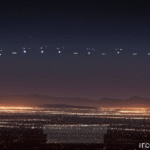What Causes the Unexplained Disappearance of the Tunguska Event?
What Causes the Unexplained Disappearance of the Tunguska Event?
The Tunguska Event, which occurred in 1908 in Siberia, remains one of the most compelling mysteries in the realm of scientific anomalies. Why did a massive explosion occur in a remote area, flattening over 2,000 square kilometers of forest, and yet leave no definitive evidence of its cause? This question is not only vital for understanding historical events but also for exploring the boundaries of scientific knowledge and the unknown. The implications of this mystery stretch into various fields, including geology, atmospheric science, and even extraterrestrial studies.
Historical Context of the Tunguska Event
On the morning of June 30, 1908, a massive explosion rocked the remote region of Tunguska in Siberia, Russia. Witnesses reported a bright flash in the sky followed by a shockwave that knocked people off their feet and flattened trees for miles. The event’s location was so remote that it took scientists decades to study it adequately. The first major scientific expedition to the site did not happen until 1927, led by the Soviet scientist Leonid Kulik.
Interestingly, there were reports of a meteoric fireball streaking through the sky before the explosion. However, no crater was found, leading to significant speculation about the event’s cause. The explosion was thought to be equivalent to 10-15 megatons of TNT, more powerful than the atomic bomb dropped on Hiroshima. The lack of physical evidence has fueled countless theories, from meteorites to antimatter explosions, making it a cornerstone case in the study of unexplained phenomena.
Core Concepts and Theories Surrounding the Event
Theories about the Tunguska Event have evolved significantly over the years. Here are some of the most notable:
- Meteorite or Comet Impact: The most widely accepted theory is that a meteorite or comet exploded in the atmosphere above Tunguska, releasing energy equivalent to a large nuclear weapon.
- Antimatter Reaction: Some fringe scientists have proposed that a small amount of antimatter could have caused the explosion. This theory, while fascinating, lacks empirical support.
- Volcanic Activity: A less popular theory suggests that volcanic activity could have been the cause, although no volcanic evidence has been found.
- UFO or Extraterrestrial Influence: Some conspiracy theorists suggest that the explosion was related to alien technology, although this lacks scientific validation.
Practical Implications of the Tunguska Event
The Tunguska Event serves as a critical reminder of the potential hazards posed by near-Earth objects. As space exploration and asteroid detection initiatives become more prevalent, understanding events like Tunguska is essential for developing effective planetary defense strategies. A large enough object could cause catastrophic damage to populated areas, making it crucial for scientists to monitor space for such threats.
Furthermore, the event has implications for the fields of geology and atmospheric science. The study of the Tunguska area has provided insights into tree growth patterns, soil composition, and how ecosystems recover from such disturbances. Understanding the ecological impact of such an explosion can inform future environmental assessments.
Alternative Perspectives on the Tunguska Phenomenon
While the most accepted theories center around asteroid or comet impacts, alternative explanations persist in popular discourse. Some researchers advocate for more unconventional theories, such as:
- Natural Gas Explosion: A theory suggests that a release of natural gas from underground could have ignited, resulting in the explosion.
- Electromagnetic Phenomena: Some have posited that a natural electromagnetic event could have caused the explosion, though this lacks substantial scientific backing.
These alternative theories often arise from the gaps in empirical evidence and the desire to explore all possibilities. However, they tend to lack the rigor of scientific scrutiny applied to more conventional theories.
Common Misconceptions about the Tunguska Event
Many misconceptions surround the Tunguska Event, often fueled by sensationalized media portrayals and conspiracy theories. Some of the most common include:
- There is a Crater: A frequent belief is that the Tunguska Event left a crater, when in fact, there is none.
- It Was a Nuclear Test: Some conspiracy theories suggest that the explosion was a secret nuclear test by the Soviet government, which is unsubstantiated.
- Immediate Human Casualties: Although there were injuries, the remote location meant that there were no immediate deaths reported, contrary to popular belief.
Best Practices for Investigating Tunguska-like Events
When studying events similar to Tunguska, scientists and researchers can employ several best practices:
- Interdisciplinary Approach: Engage experts from various fields, including geology, astrophysics, and environmental science, to gather comprehensive data.
- Utilize Modern Technology: Use satellite imagery, ground-penetrating radar, and drones to analyze hard-to-reach areas.
- Public Engagement: Involve local communities in research efforts, as they can provide valuable eyewitness accounts and observations.
By following these practices, researchers can enhance their understanding of similar phenomena and contribute to the broader field of scientific inquiry.
Future Developments and Ongoing Research
Research into the Tunguska Event is ongoing, with scientists continually seeking new insights. Current studies focus on:
- Remote Sensing Technology: Advancements in remote sensing allow for more detailed analysis of the event’s impact on the environment.
- Comparative Analysis with Other Events: Recent studies are comparing Tunguska with other historical events like the Chelyabinsk meteor in 2013 to better understand the mechanisms behind such explosions.
- Public Policy on Near-Earth Objects: Findings from Tunguska inform policies related to monitoring and potentially deflecting hazardous asteroids.
As technology advances, the potential for new discoveries about the Tunguska Event and similar occurrences will likely grow, leading to a better understanding of our planet’s interactions with space.
Conclusion
The Tunguska Event remains a captivating case that challenges our understanding of natural phenomena and their potential implications. From its historical context to ongoing research, the mystery of this explosion continues to intrigue scientists and laypeople alike. While the prevailing theory suggests an airburst of a comet or asteroid, alternative explanations and misconceptions persist, underscoring the complexities of scientific inquiry. As we advance our technologies and methodologies, we may one day unravel the remaining mysteries surrounding this extraordinary event, paving the way for more informed approaches to planetary defense and environmental studies.
Other Articles
Recent Posts
- What Happened to Flight MH370? The Conspiracy Theories That Still Haunt Us
- What Secrets Lurk Within the Walls of the Infamous Trans-Allegheny Lunatic Asylum?
- What Evidence Supports the Existence of Bigfoot in the Pacific Northwest?
- What Happened to the Indus Valley Civilization? Unraveling the Mysteries of Ancient Urban Life
- Can Telepathy Be Scientifically Proven Through Laboratory Evidence?







